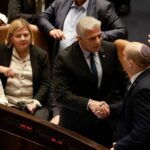
The North Atlantic Treaty Organization was established in 1949 following the death of 250 million people in two world wars the first 50 years of the 20th century.
It’s been the most effective alliance in history, having preserved a rule based comparative peace enabling 70 years of worldwide human progress: Entire diseases have been eradicated, the world’s population has tripled and humanity today enjoys more individual freedom and national self-determination than ever before in history.
NATO’s initial mission was to “Keep the Americans and British in, the Germans down, and Russians out.”
It was supported by an array of international institutions and alliances like the United Nations, World Bank, Southeast Asia Treaty Organization (SEATO) and a Middle East alliance (CENTO), created to contain a perceived international Communist threat. It led to today’s European union.
Hear more Tennessee Voices: Get the weekly opinion newsletter for insightful and thought provoking columns.
How Putin emerged
A dedicated Russian Nationalist and former KGB agent, Putin was stationed in East Germany when the USSR collapsed. He emigrated back to Moscow finding Russia in chaos, faced down the oligarchs, a small group of businessmen who today control the economy and achieved absolute power.
Simultaneously, NATO expanded into the former Soviet empire countries and under the reassurance of NATO, Ukraine, the ‘bread basket’ of Europe, abandoned its nuclear weapons but did not join NATO.
America gradually drew down our European troop presence while President Obama announced a ‘pivot towards Asia’ and President Trump frequently referred to NATO as ‘outmoded.’
Putin claims Russia requested NATO membership and its expansion threatens Russia, propaganda which only makes sense if his aim is to attack the defensively structured alliance which of course it is. He was emboldened by his Crimean annexation and simultaneous use of chemical weapons in Syria which President Obama failed to respond to after pledging, he would.
The new world disorder and the lessons of Nazi Germany
The effectiveness of the Ukrainian army’s response on the ground has been expectedly effective due to their defending their families and homeland from foreign invaders. NATO’s recognition of the seriousness of continued Russian expansionism is encouraging. There’s widespread agreement with the apt comparison with Hitler’s restoring order to a chaotic Germany in the early 1930s and subsequent aggression leading to WWII.
It’s now crystal-clear Putin’s an unprincipled murderous dictator trying wanting to restore the former USSR. Ukraine has become a ‘buffer state’ where a hot sequel to the former cold war is joined. President Biden’s resurrection of the WWII Lend Lease program is evidence of how serious America and NATO take the invasion.
Putin’s fall-back invasion strategy is to connect previously annexed north eastern Ukraine with Crimea and the sea ports of Mariupol and Odessa to the south. Putin now hopes to strangle Ukraine which needs ports to export the wheat which supplies 80% of Egypt’s needs and much of Africa.
The Way Forward
NATO has been unified and will benefit from the membership of Finland and Sweden.
Finland adds substantial military capability having held off Russian invasions historically and both protect NATO’s northern flank and the vulnerable Baltic States. For an empowered Ukraine and revitalized NATO, the goal must now be to preserve Odessa or another channel for exporting Ukrainian grain.
NATO’s demonstrated remarkable unity in creating economic sanctions. But sanctions will take time impact Russian expansionism.
The final outcome of this chapter two of the post WWII cold war, now hot, will be determined by the combination of the sanction’s long-term effectiveness and most importantly the ability to the Russian people to throw off the yoke tyranny that Vladimir Putin has become.
John A. Knubel is a resident of Franklin, Tennessee.
This article originally appeared on Nashville Tennessean: Opinion: How Russia’s invasion into Ukraine strengthens NATO alliance




